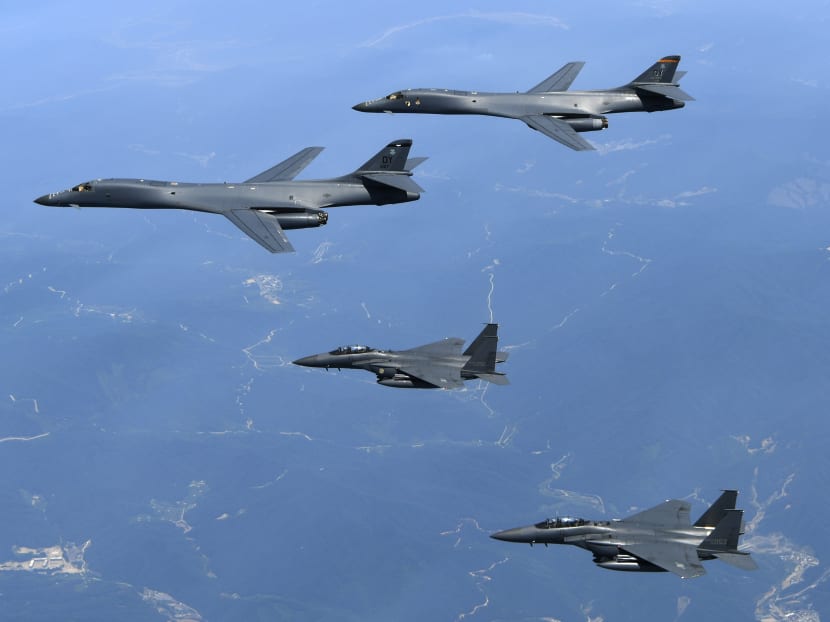Joint exercises could send Korea tensions soaring again
SEOUL — After North Korea and the United States traded bellicose threats of nuclear conflagration, all eyes will be on an annual war game in the South next week that could send tensions spiralling back upwards, analysts say.

In this June 20, 2017 file photo provided by South Korean Defence Ministry, American Air Force B-1B bombers, top, and second from top, and South Korean fighter jets F-15K fly over the Korean Peninsula, South Korea. Source: AP
SEOUL — After North Korea and the United States traded bellicose threats of nuclear conflagration, all eyes will be on an annual war game in the South next week that could send tensions spiralling back upwards, analysts say.
Pyongyang tested two intercontinental ballistic missiles (ICBM) last month that appeared to bring much of the US within range, triggering an intense warning by President Donald Trump that Washington could rain “fire and fury” on the North.
Pyongyang then threatened to fire a salvo of missiles towards the US territory of Guam - a plan that leader Kim Jong-un this week delayed, but warned could go ahead depending on Washington’s next move.
The North’s reaction to the “Ulchi Freedom Guardian” (UFG) joint military exercise that starts next Monday (Aug 21) will be key to determining what happens next.
The annual drills - described as defensive and named after a general who protected an ancient Korean kingdom from Chinese invaders - will involve about 50,000 South Korean and 17,500 US troops, Seoul’s defence ministry said Friday (Aug 18).
But Pyongyang views them as a highly provocative rehearsal for an invasion of its own territory, and threatens strong military counteraction each year.
The North said the Guam missile strike could be reinstated in the event of “reckless actions” by Washington, and analysts say the exercise could become an alarming flash point.
“I worry it might enact this plan when the joint exercises start,” said Mr James Acton, co-director of the Nuclear Policy programme at the Carnegie Endowment for International Peace.
North Korea has repeatedly called for an end to large-scale joint military exercises between the allies in exchange for a freeze on its nuclear and missile programmes.
In the early 1990s Seoul and Washington agreed to cancel a drill then known as Team Spirit in return for the North allowing an inspection of its secret nuclear facilities - only to see Pyongyang later walk away and resume its weapons development.
Mr Vipin Narang, an associate professor at the Massachusetts Institute of Technology specialising in nuclear strategy, warned against another suspension.
“Cancelling it would cede into the huge North Korean aim to decouple the allies and drive a wedge between South Korea and the United States,” Assoc Prof Narang told AFP.
Pushing through with the drills is essential for South Korean President Moon Jae-in’s promise to “prevent war at all cost”, said Mr Choi Kang of the Asan Institute of Policy Studies.
“Seoul will say the current tensions call for an even stronger alliance and closer military cooperation,” he said.
The US State Department said this week the largely computer-simulated UFG exercise, which dates back to 1976, will go ahead as planned.
But it declined to comment on whether the drills would be scaled back in an effort to ease tensions.
The US troop numbers given by Seoul’s defence ministry represent a cutback from last year, when 25,000 were involved.
The allies could look to make a conciliatory gesture towards Pyongyang by not involving US strategic assets such as stealth bombers or aircraft carriers, said Mr Koo Kab-Woo, a professor at the Seoul-based University of North Korean Studies.
Supersonic B-1B bombers from the US Pacific Command’s Andersen Air Force Base in Guam are often flown over the peninsula for joint exercises and to demonstrate Washington’s “full range of military capabilities” - always infuriating Pyongyang.
When Mr Kim delayed his Guam missile plan, he warned the US to end its “arrogant provocations” and referred to what he called “huge nuclear strategic equipment” being brought to the region.
In an ideal scenario, Mr Acton of the Carnegie Endowment for International Peace said, the two sides would agree that North Korea could not carry out missile tests that overfly South Korea or Japan - which would preclude them getting anywhere near Guam - in exchange for the US ending strategic bomber training flights within an agreed distance of the North.
North Korea appears to have left open some room for a quid pro quo, added Assoc Prof Narang.
Any negotiation for a quiet agreement to reduce the frequency and range of the B-1B flights “doesn’t have to be terribly public and it could be behind the scene”, he said. “I think it’s reasonable to think that might go somewhere.” AFP






